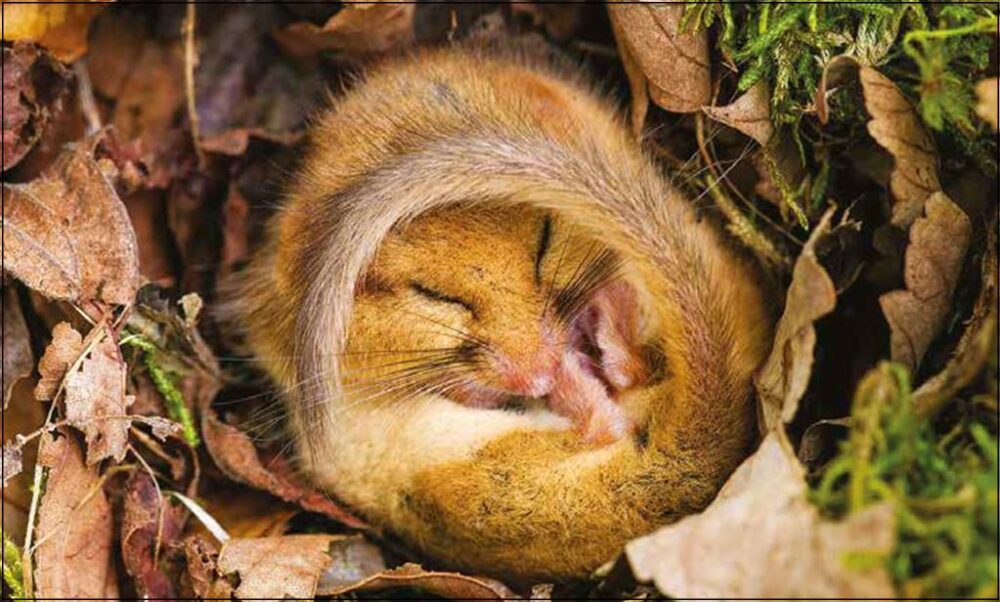It’s getting to that time of year where some of our UK species are starting to wind down for the winter. One of these is the hazel dormouse, whose name derives from the Latin word ‘dorm’, meaning ‘sleep’ and the old English/German word ‘mus’, meaning ‘mouse’.
Dormice are found throughout England and Wales in suitable habitat though they are encountered more frequently in the South and West. Typical dormouse habitat consists of broadleaved woodland particularly those with diverse species and a well-developed shrub and ground layer. They can, however, also be found in young commercial crops with a well-developed understorey within dormouse areas.
From around October to the end of March, dormice hibernate, but this is dependent on local seasonality. Hibernation is often referred to as a long sleep, but it’s far more than that. Their body temperature drops, heart rate and breathing slow right down, using this technique to save energy over winter. So, in the autumn, to prepare for hibernation, dormice begin to fatten themselves up, gorging on hazelnuts, and other nuts and berries to increase their chances of survival.
Once they’re ready, they come down from the shrub layer to the ground level and make themselves a small nest on the ground, essentially cocooning themselves with dry vegetation, leaf litter etc. to try and insulate themselves as much as possible. These hibernation nests can be found in tree hollows, brash piles, log piles, log stacks and coppice stools, and sometimes even leaf litter on the ground. Excessive environmental change can lead to premature ‘wakening’ with potential negative consequences, for instance the occasional warmer day over winter can result in this. Certain forest operations in the winter months could potentially harm dormice whilst hibernating, particularly those associated with harvesting. To this end, Natural England has produced a protocol outlining the risks and describing best practice which avoids negative outcomes for dormice. Unlicensed, deliberate, or reckless disturbance of a dormouse is an offence which can result in an unlimited fine or even a prison sentence. It is incumbent on anyone working in potential dormouse habitat to familiarise themselves with the law and ensure adequate measures are put in place to prevent an offence being committed. Early consultation with a Tilhill ecologist is always advised when planning works.
The following points highlight the main issues:
CLEAR FELLING/THINNING
Working around dormice when clear felling or thinning can be a difficult task and is entirely dependent on the woodland, coupe ages and the areas of favourable/ non-favourable habitat and often comes down to only clearing a certain percentage of the woodland. It is best to consult with a Tilhill ecologist if you are needing to clear fell/thin within potential dormouse habitat.
EXTRACTION
Where possible remove material using a forwarder rather than a skidder, minimising any extraction routes. If you are having to extract from steep slopes, where skidding or high leading is the only option, then avoid doing this in the hibernation period in any favourable habitat.
LOG STACKS
If you are in an area with potential for dormice, any log stacks must be removed before the pre- hibernation period/hibernation period begins (mid-September/end of October), as you may be providing a suitable hibernacula for dormice. If this can’t be done, the log stacks must be left until the end of March/warmer weather when the dormice are likely to be active again, however consult with Tilhill’s ecologists for advice as it may be possible to remove the log stacks under the watchful eye of a licenced dormouse ecologist. The best way to avoid complications is to remove any timber stacks promptly after felling, if any felling is done between October and March. Ideally timber stacks should be placed on hard standing/areas of short vegetation, and raised off the ground where possible.
BRASH PILES
If you are contemplating chipping or burning of any brash piles within a dormouse potential area, avoid doing so until they become active again in April/May.
RIDE MANAGEMENT
Any areas with a short sward can be mowed, but the areas of taller sward, shrubs or woody vegetation should be treated with caution. For example, in a dormouse favourable area, there are maximum areas that can be cut, only working less than 10% of the favourable/marginal habitat. Please consult with a Tilhill ecologist in this instance.



